Here’s a brief look at the Sigma 18-50mm F/2.8 EX DC macro zoom lens. Scroll down for the review.
|
Lens
|
Sigma 18-50mm F/2.8 EX DC macro zoom lens
|
|
Box contents
|
Front and rear caps, hood, nice soft-case and users manual.
|
|
Cost
|
$419 street price.
|
|
Build quality
|
Good to very good
|
|
Additional information
|
|
Specifications below
|
|
|
Optical configuration
|
15 elements in 13 groups
|
|
Angle of view
|
76°-32° with 1.5x crop sensor
|
|
Aperture
|
7 blades, circular
|
|
Full frame and APS-C
|
APS-C only, 35mm equivalent, 27-75mm. Works on full frame, but vignettes massively at all focal lengths, turn on APS-C size capt. for good pictures.
|
|
Depth of field and focus scales?
|
Focus distance scale
|
|
Minimum focus, image plane to subject
|
7.9″ (200mm)
|
|
Minimum focus, end of lens barrel to subject
|
1.0″ (25.4mm)
|
|
Hard stop at infinity focus?
|
No |
|
Length changes when focusing?
|
No
|
|
Focus ring turns in AF?
|
Yes
|
|
Filter size
|
72mm
|
|
Filter ring rotates?
|
No
|
|
Distance encoder?
|
?
|
|
Max magnification
|
0.34x
|
|
Min. F/stop
|
F/22
|
|
Sony teleconverter compatible?
|
No
|
|
Length changes when zooming?
|
Yes
|
|
Dimensions W x L (my measurements)
|
3.1″ x 3.4″ 79mm x 86mm-around filter ring
|
|
Maximum extended length (my measurements)
|
4.4″ (111mm)
|
|
Weight bare (my scale)
|
16.9oz (479g) 17.8oz (506g) with caps
|
Requisite product shots.
 |
| Box and contents |
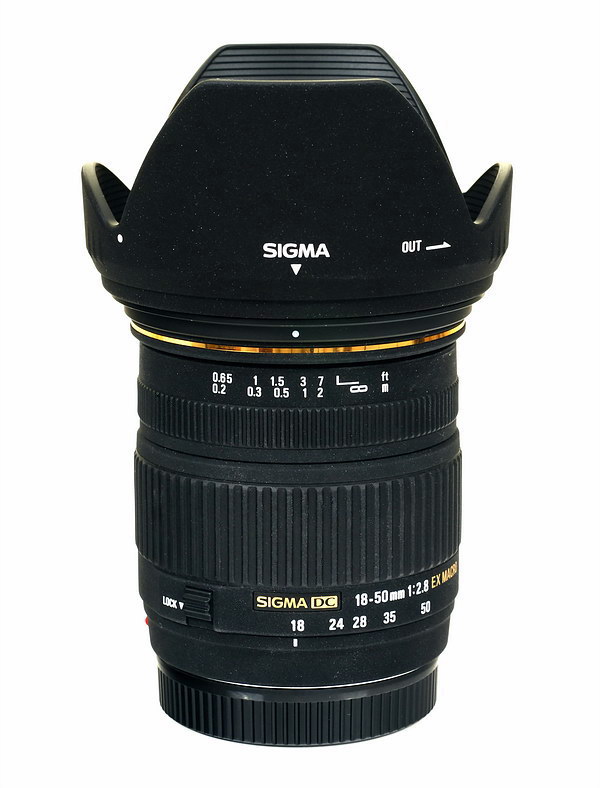 |
| Side view fully drawn in, with included hood, note zoom lock. |
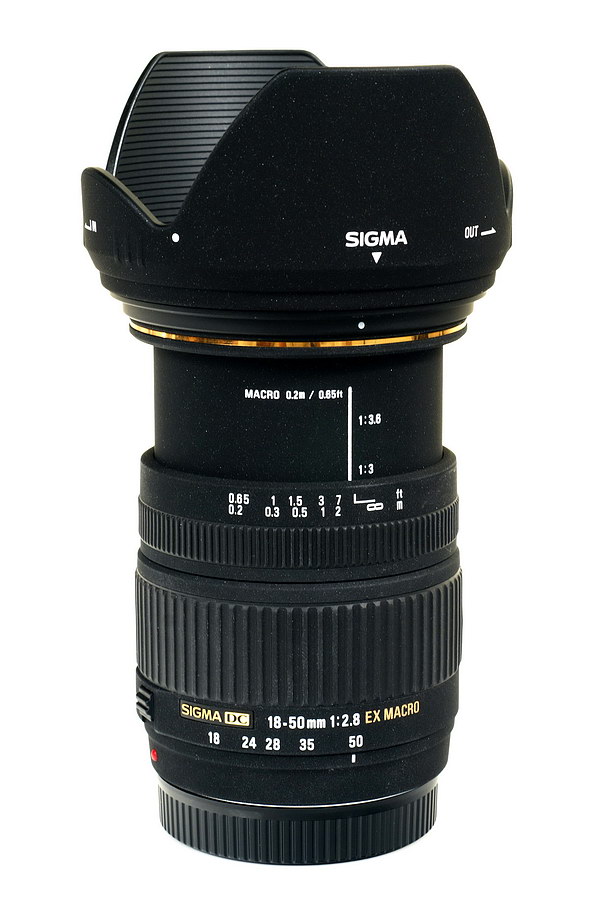 |
| Side shot fully extended, note sparkly dirt like finish |
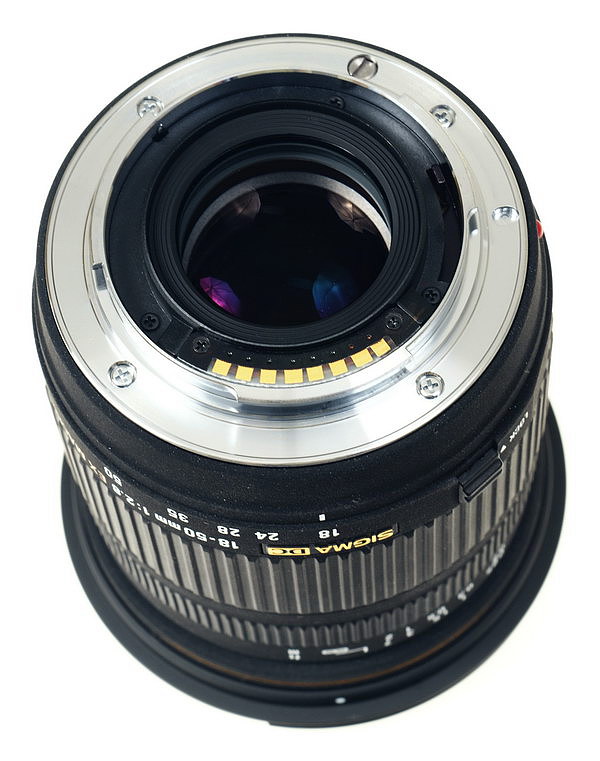 |
| Rear shot |
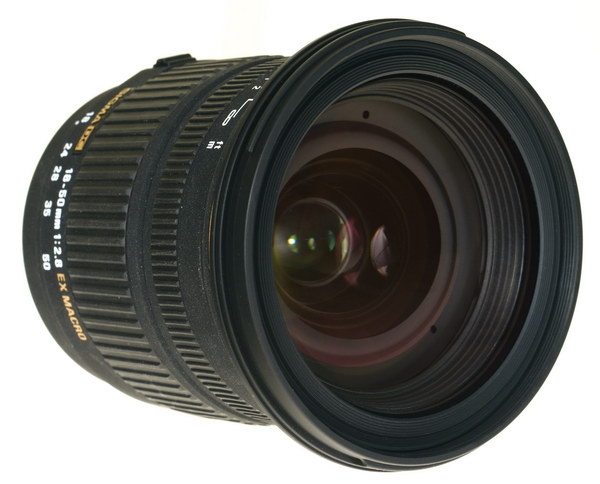 |
| Big front element |
 |
| Sigma MTF screen grab, incomplete, but this is all they give. |
The
Sony A700 was used for this review. For a better understanding of my review methods and terminology,
go here.
The Sigma 18-50mm F/2.8 EX macro lens, made in Japan, is equivalent in focal range to most standard walk-around zooms, but has the constant fast aperture of F/2.8, which the others don’t have. Currently, Sony has no fast lens like this in the APS-C or “DT” only category. Sigma says they use two asperical elements and one “SLD” element in the construction of the lens. It has a 7 blade circular aperture. This lens handles very nicely, and seems better in some respects than Sony branded lenses. The actual construction quality is pretty good, my only complaint is the atrocious sparkly-dirt finish they apply. I just hate it and you can see what I’m talking about by looking at the product shots above. Other than that, everything is right. A few items to note; if you set this lens mount-side down at 18mm without the rear cover on, the rear element will touch the surface and cause the lens to wobble slightly. The “DC” in the lens name means it’s for APS-C sensors only, and the “EX” means it has gold stuff on the barrel to make it look like it’s higher quality. Also, the owners manual says not to use gasoline or fuel oil to clean the lens, darn it! They didn’t say anything about not smoking a cigarette if you should do so.
Zoom control is smooth and even, and dampened nicely. It extends out 1.0″ (25.4mm) at 50mm. This lens extends out as you turn the zoom ring counter-clockwise, the opposite of most Sony/Minolta lenses. The focal length numbers are checked at; 18mm, 24mm, 28mm, 35mm, and 50mm. The EXIF data reads correctly. The lens has a Zoom lock, and works only at 18mm, but you shouldn’t need it unless you like to hike or run with it.
Focusing is a mixed bag. Don’t get upset now, auto-focusing works good, maybe a little slow, but at F/2.8 it can render images slightly out-of-focus at times, just check your shots occasionally when shooting at F/2.8. The focus ring turns in AF. Manual focusing works well, with about 1/6 of a turn from close-in to infinity. The focus ring is nice and tight, with no slop. The closest focusing distance from lens barrel to subject is 1.0″ or 25.4mm.
Flare and ghosting. Average control at ghosting. Green blobs, sometimes large depending on angle, see image below. Flare is strong when the sun is at, or just out of the frame, especially towards the long end. The lens comes with a plastic petal-type hood which isn’t very effective for controlling flare or ghosting, use your hand when needed.
This lens is multi-coated and has the common green/magenta look that matches some Sony lenses perfectly.
Filter size. 72mm. This size isn’t very popular with Sony, but they do use it on the 20mm F/2.8, 135mm F/2.8 STF, and the 85mm F/1.4
Filter use. There’s very light vignetting using regular filters at 18mm, F/2.8.
Coma. Light wide open, 18-24mm, closing the aperture one or two stops eliminates it. No issues from 35-50mm.
Color. Looks the same as Sony lenses.
Lateral color fringing. Very good control here at the long end, say 35mm-50mm. At wide angle it’s about average, I see mostly purple/red. Stopping down doesn’t help with this kind of color fringing.
 |
| Moderate to strong barrel distortion. 18mm |
 |
| Light pincushion distortion at 50mm. |
Barrel and pincushion distortion. The distortion at 18mm is moderate to strong, but disappears rapidly, 22mm-30mm is flat. From 32mm pincushion starts, and results in light to moderate distortion at 50mm. See pictures above. Oddly, distortion seems strongest at 50mm, which turns into barrel (not pincushion as above) focused very close, as in large macro image, see stamp macro below.
Lens Bokeh. The Sigma 18-50mm F/2.8 EX DG macro has a decent background blur near 18mm, F/2.8, but looks too harsh towards the long end. See images below.
light fall-off, directly below. Moderate at 18mm and F/2.8, stopping down helps out. Other focal lengths look mild. Usually, closing the aperture one stop will eliminate most of the dark corners, but there isn’t a problem except possibly wide open at 18mm. See small image sample below the test shots, where it’s hardly visible.
|
18mm @ F/2.8
|
18mm @ F/4
|
 |
 |
|
50mm @ F/2.8
|
50mm @ F/4
|
 |
 |
Examples of light fall-off and flare.
|
18mm @ F/2.8 Light fall-off
|
18mm @ F/5.6 ghosting
|
 |
 |
|
18mm @ F/2.8 bokeh
|
18mm @ F/4 bokeh
|
 |
 |
|
50mm @ F/2.8 bokeh
|
50mm @ F/4 bokeh
|
 |
 |
|
18mm @ F/2.8 coma
|
18mm @ F/4 coma
|
 |
 |
The top left picture above shows light fall-off or corner shading at 18mm, F/2.8, which is barely noticeable in real shots, this is also laughable because you very rarely need to shoot F/2.8 in daylight, this shot was 1/3200 sec. The top right image is ghosting at 18mm, F/5.6, which is average, to slightly below average in this department. No problems with the sun centered in the image. Flare is strong, especially at the long end.
Bokeh examples in the middle, and they really aren’t too smooth. At full wide angle and F/2.8, things look ok, but stopped down, or anything at the long end is harsh.
Coma, bottom row, looks light, and is completely gone at F/5.6 @18mm. Light to nothing past 24mm.
Corner softness.
18mm corners below.
|
18mm @ F/2.8
|
18mm @ F/4
|
 |
 |
|
18mm @ F/5.6
|
18mm @ F/8
|
 |
 |
|
50mm @ F/2.8
|
50mm @ F/4
|
 |
 |
|
50mm @ F/5.6
|
50mm @ F/8
|
 |
 |
The 18mm corners are soft with the aperture wide open, and stopping down helps much, F/8 looks good. Up towards 50mm, the corners don’t start off as soft as they are at 18mm, and respond nicely to a couple stops down to F/8. Basically, the wide end takes three stops to get sharp corners, 50mm; two stops. With the aperture closed to F/5.6, the corners are sharp enough at all lengths to please most people, unless you like staring at your pictures blown up on your computer screen to insane levels. If you’re taking pictures in broad daylight, you won’t need F/2.8, and more likely will be shooting at F/5.6-8, so again, corner softness doesn’t matter here.
Center samples next.
18mm centers
|
18mm @ F/2.8
|
18mm @ F/4
|
 |
 |
|
18mm @ F/5.6
|
18mm @ F/8
|
 |
 |
|
50mm @ F/2.8
|
50mm @ F/4
|
 |
 |
|
50mm @ F/5.6
|
50mm @ F/8
|
 |
 |
Look at the boring center crops above. With a wide open aperture the centers are pretty sharp, but one stop down looks a bit sharper. You’ll only notice the sharpness differences if you compare the 100% crops side-by-side like I’ve done here.
Check out the close focus shot.
Below, check out the sample (610kb) and click to see a 100% cropped portion of the full image. The sample shot was taken with the
Sony A700 12.2MP camera. The subject is a standard US stamp, 1″x 3/4″ or 25.4mm x 19mm. Also, note the macro shot was taken as close to the subject as focusing allowed; In this case a super close 1.0″ or 25.4mm, measured from the front of the lens barrel to the subject.
This lens has a large reproduction size at 0.34x. It did a good job at F/8 but F/11 is just as sharp. The macro shot below is a little dark in the middle, as I was so close (1.0″) away, the lens barrel blocked my light. This is a problem in the field, so you may not be able to get the full reproduction size macro unless the conditions are just right. Also notice the barrel distortion in the crop below, funny how it has pincushion at 50mm with normal focus distances, and barrel at close focus.
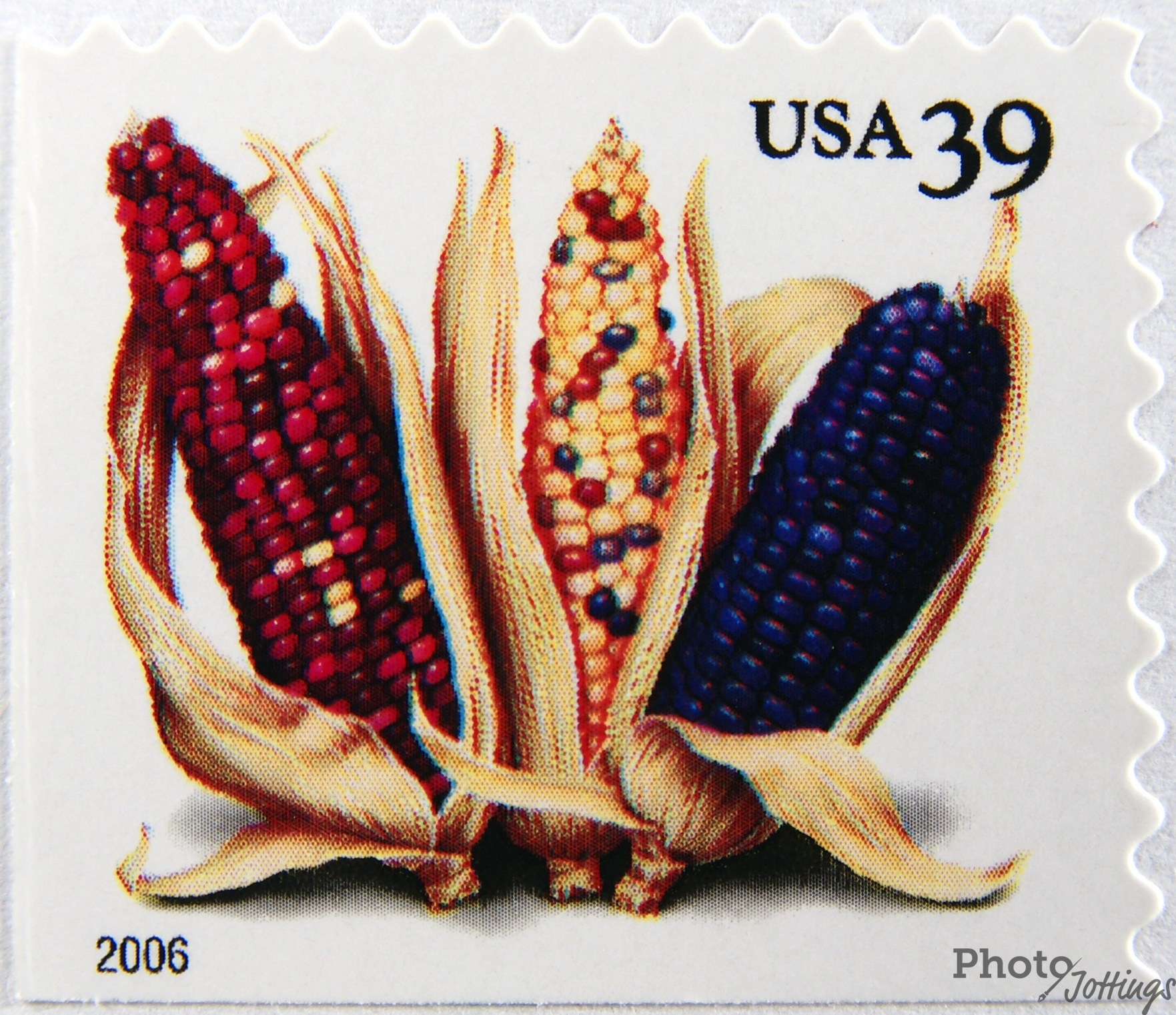 |
| 100% crop, F/8 click me |
Conclusion.
The Sigma 18-50mm F/2.8 EX macro lens is well built, (but ugly, sparkly, dirt-look finish), handles nicely and is sharp in the centers at all focal lengths, even wide open, and produces an excellent macro image. Average items include color fringing at wide angle, though good at 50mm, distortion, and light fall-off. Below average items include flare control, corner softness at wide angle, and accurate focusing at large apertures; check your shots. The soft corners don’t matter in good light, where you’ll probably be using F/5.6-8 and won’t be needing F/2.8. In low-light, soft corners won’t show up much. This lens performs similarly to the
Konica Minolta AF 28-75mm F/2.8 lens, but the Sigma has a much better focal length for APS-C cameras, equalling 27-75mm, where the Konica Minolta is 42-112mm.
Overall, this is a very good lens, and is a bargain, with a street price around $419.
Sigma replaced this review lens with a
better version, not yet reviewed.




































